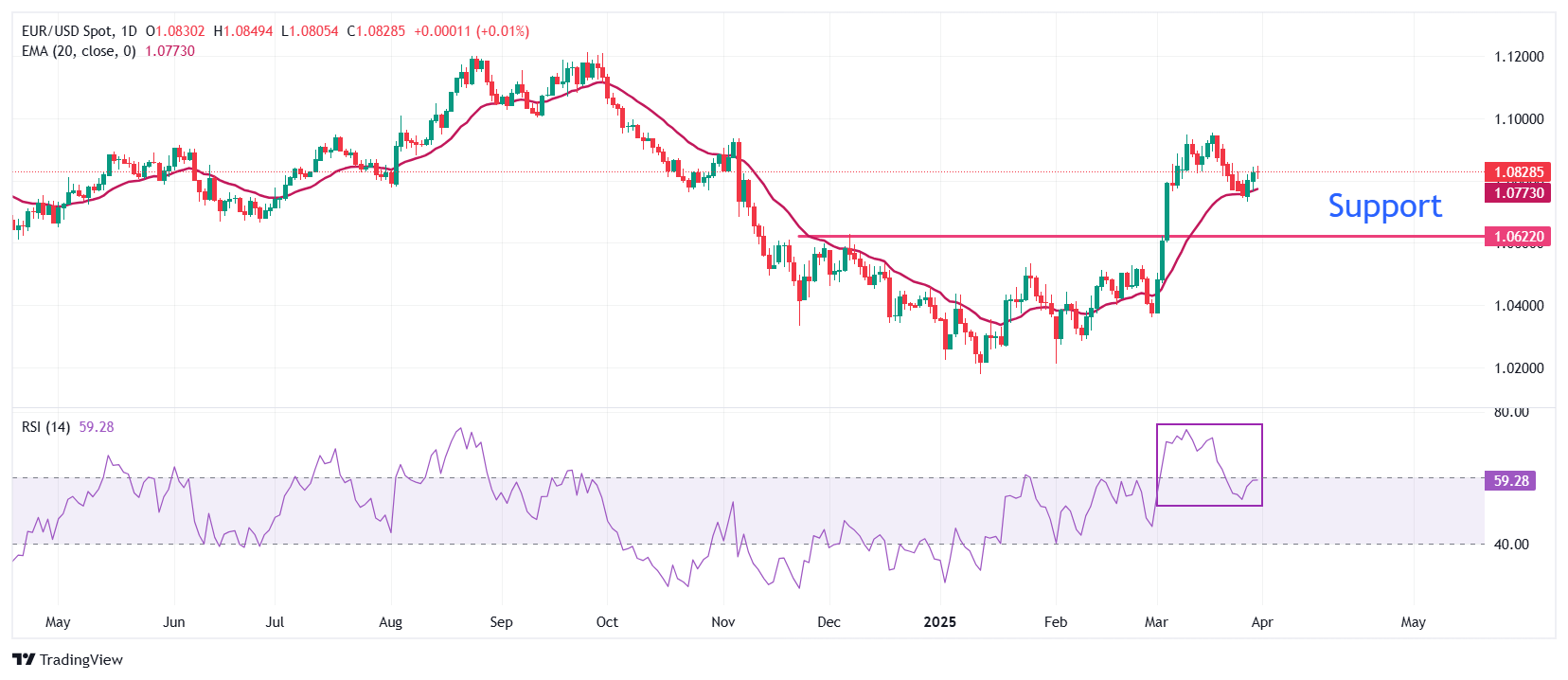-
EUR/USD hovers near 1.0830 as investors remain cautious ahead of Trump’s reciprocal tariff announcement on Wednesday.
-
The US Dollar's movement this week will be shaped by the US ISM PMI and key employment data, culminating in Friday’s NFP for March.
-
The EU Commission consents to offering a ‘term sheet’ of concessions to the US.
EUR/USD remains steady around 1.0830 in Monday’s European session as the US Dollar (USD) continues its decline for the third consecutive trading day. Investors remain cautious ahead of US President Donald Trump’s planned reciprocal tariff announcement on Wednesday. The US Dollar Index (DXY), which measures the Greenback against six major currencies, slides to a fresh 10-day low near 103.75.
Market participants anticipate that Trump's new tariffs could negatively impact global economic growth and fuel inflation, including in the US. According to the Washington Post, Trump has been urging his advisers to strengthen trade measures and has revived the idea of a universal tariff applying to most imports, regardless of origin. The report also highlighted that Trump regretted not imposing broader tariffs in his first term and believes such measures would benefit the US by boosting manufacturing jobs and generating trillions in government revenue.
This week, investors will closely watch key US economic data, including the ISM Manufacturing and Services Purchasing Managers' Index (PMI) and labor market indicators, which could shape market expectations for the Federal Reserve’s (Fed) monetary policy outlook.
According to the CME FedWatch tool, the Fed is expected to maintain interest rates at their current levels in its May meeting. However, the likelihood of a rate cut in June has risen to 83.5%, up from 65.6% recorded a week ago.
Daily Market Movers: EUR/USD Eyes German HICP Data
- On Monday, the Euro (EUR) could see movement based on preliminary German Harmonized Index of Consumer Prices (HICP) data for March, scheduled for release at 12:00 GMT. German HICP is expected to rise by 2.4% year-over-year, down from the 2.6% increase seen in February.
- Last Friday, preliminary inflation data from France and Spain showed price pressures easing more than expected. However, German inflation figures are unlikely to significantly influence the European Central Bank’s (ECB) monetary policy outlook, as investors anticipate renewed inflationary pressures in the Eurozone due to Trump’s tariff policies.
- Traders expect President Trump to target the Eurozone with significant tariffs, as he has criticized the European Union (EU) for not purchasing enough American goods. According to the World Population Review, Ireland and Germany ranked as the fourth and fifth largest nations with a trade surplus with the US in 2024. If implemented, Trump's higher import duties on the Eurozone could weigh heavily on its economic growth.
- During European trading hours, ECB President Christine Lagarde warned that an escalating trade war would be a "lose-lose" scenario, potentially reducing Eurozone growth by at least 0.3%.
- Last week, Trump imposed 25% tariffs on foreign car and light truck imports, set to take effect on Wednesday. In response, the EU Commission initially warned of retaliatory measures but later agreed to offer concessions to the US in an effort to secure the partial removal of existing tariffs, which are expected to rise further on April 2, according to Bloomberg.
Technical Analysis: EUR/USD Holds Firm Around 1.0830

EUR/USD trades with little directional bias around 1.0830 at the start of the week. The pair maintains a firm near-term outlook as it continues to hold above the 20-day Exponential Moving Average (EMA), which sits near 1.0773.
The 14-day Relative Strength Index (RSI) has cooled below 60.00, suggesting a loss of bullish momentum, though the overall upside bias remains intact.
On the downside, the December 6 high of 1.0630 serves as a key support zone. Conversely, the psychological level of 1.1000 remains a crucial resistance point for Euro bulls.





